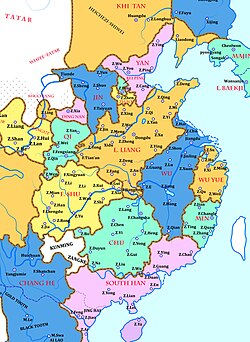Ma Chu
Chu Sở | |||||||||
|---|---|---|---|---|---|---|---|---|---|
| 907–951 | |||||||||
 | |||||||||
| Capital | Changsha | ||||||||
| Common languages | Middle Chinese | ||||||||
| Government | Monarchy | ||||||||
| Prince/King | |||||||||
• 907–930 | Ma Yin | ||||||||
• 950–951 | Ma Xichong | ||||||||
| Historical era | Five Dynasties and Ten Kingdoms Period | ||||||||
• Became the State | 907 | ||||||||
• establishment of the Kingdom | 927 | ||||||||
• Ended bySouthern Tang | 951 | ||||||||
| Currency | Silk,Cash coins(Iron) | ||||||||
| |||||||||
| Today part of | China | ||||||||
Chu(Chinese:Sở;pinyin:Chǔ), known in historiography asMa Chu(Mã sở) orSouthern Chu(Nam sở), was adynastic state of Chinathat existed from 907 to 951. It is counted as one of theTen Kingdomsduring theFive Dynasties and Ten Kingdoms periodof Chinese history.
Founding[edit]
Ma Yinwas named regional governor by theTangcourt in 896 after fighting against a rebel namedYang Xingmi.He declared himself as the Prince of Chu with the fall of theTang dynastyin 907. Ma's position as Prince of Chu was confirmed by theLater Tangin the north in 927 and was given the posthumous title of King Wumu of Chu.
Territories[edit]
The capital of the Chu Kingdom wasChangsha(Tanzhou).[1]The kingdom ruled over present-dayHunanand northeasternGuangxi.
Economy[edit]
Chu was peaceful and prosperous under Ma Yin's rule, exportinghorses,silkandtea.Silk and lead coinage were often used ascurrency,particularly with external communities which would not accept othercoinageof the land. Taxation was low for the peasantry and merchants.
Fall of Chu[edit]
AfterMa Yindied the leadership was subject to struggle and conflict which resulted in the fall of the kingdom. TheSouthern Tang,fresh from its conquest of theMin Kingdom,took advantage and conquered the kingdom in 951. The ruling family was removed to theSouthern Tangcapital ofJinling.However, the following year, Chu generals rose against Southern Tang and expelled the Southern Tang expeditionary force, leaving the former Chu territory to be ruled by several of those generals calledWupingJiedushi( võ bình quân tiết độ sứ ) in succession.
Zhou Xingfeng(Chu hành phùng) ruled the Jiedushi from 956-962. In 956, Zhou Xingfeng executed and beheadedPan Shusi(Phan thúc tự), a general of the Southern Chu.[2][3]
During these post-Chu years ofde factoindependence, the center of power was usually at Lang Prefecture ( lãng châu, in modernChangde,Hunan).
In 963, the Wuping Jiedushi ended and its territory was seized by theSong dynasty.
Rulers[edit]
| Temple Names (Miao HaoMiếu hiệu;miaò haò) | Posthumous Names (Shi HaoThụy hào) | Personal Names | Period of Reigns | Era Names (Nian HaoNiên hiệu) and their according range of years |
|---|---|---|---|---|
| Did not exist | Wǔmù WángVõ mục vương | Mǎ Yīn Mã ân |
907–930 | Did not exist |
| Did not exist | None (commonly known as Prince of Hengyang (Hành Dương vương;Héngyáng Wáng)) | Mǎ Xīshēng Mã hi thanh |
930–932 | Did not exist |
| Did not exist | Wénzhāo WángVăn chiêu vương | Mǎ Xīfàn Mã hi phạm |
932–947 | Did not exist |
| Did not exist | None (commonly known as Deposed Prince (Phế vương;Fèi Wáng)) | Mǎ Xīguǎng Mã hi quảng |
947–951 | Did not exist |
| Did not exist | Gōngxìao WángCung hiếu vương | Mǎ Xī'è Mã hi ngạc |
951 | Did not exist |
| Did not exist | Did not exist | Mǎ Xīchóng Mã hi sùng |
951 | Did not exist |
Ma rulers family tree[edit]
| Ma Chu rulers family tree | |||||||||||||||||||||||||||||||||||||||||||||||||||||||||||||||||||||||||||||||||||||||||||||||||||||||||||||||||||||||||||||||||||||||||||||||||||||||||||||||||||||||||||||||||||||||||||||||||||||||||||||||||||||||||||||||||||||||||||||||||||||||||||||||||||||||||||||||||||||||||||||||||||||||||||||||||||||||||||||||||||||||||||||||||||||||||||||||||||||||||||||||
|---|---|---|---|---|---|---|---|---|---|---|---|---|---|---|---|---|---|---|---|---|---|---|---|---|---|---|---|---|---|---|---|---|---|---|---|---|---|---|---|---|---|---|---|---|---|---|---|---|---|---|---|---|---|---|---|---|---|---|---|---|---|---|---|---|---|---|---|---|---|---|---|---|---|---|---|---|---|---|---|---|---|---|---|---|---|---|---|---|---|---|---|---|---|---|---|---|---|---|---|---|---|---|---|---|---|---|---|---|---|---|---|---|---|---|---|---|---|---|---|---|---|---|---|---|---|---|---|---|---|---|---|---|---|---|---|---|---|---|---|---|---|---|---|---|---|---|---|---|---|---|---|---|---|---|---|---|---|---|---|---|---|---|---|---|---|---|---|---|---|---|---|---|---|---|---|---|---|---|---|---|---|---|---|---|---|---|---|---|---|---|---|---|---|---|---|---|---|---|---|---|---|---|---|---|---|---|---|---|---|---|---|---|---|---|---|---|---|---|---|---|---|---|---|---|---|---|---|---|---|---|---|---|---|---|---|---|---|---|---|---|---|---|---|---|---|---|---|---|---|---|---|---|---|---|---|---|---|---|---|---|---|---|---|---|---|---|---|---|---|---|---|---|---|---|---|---|---|---|---|---|---|---|---|---|---|---|---|---|---|---|---|---|---|---|---|---|---|---|---|---|---|---|---|---|---|---|---|---|---|---|---|---|---|---|---|---|---|---|---|---|---|---|---|---|---|---|---|---|---|---|---|---|---|---|---|---|---|---|---|---|---|---|---|---|---|---|---|---|---|---|---|---|---|---|---|---|---|---|---|---|---|---|---|---|---|---|---|
| |||||||||||||||||||||||||||||||||||||||||||||||||||||||||||||||||||||||||||||||||||||||||||||||||||||||||||||||||||||||||||||||||||||||||||||||||||||||||||||||||||||||||||||||||||||||||||||||||||||||||||||||||||||||||||||||||||||||||||||||||||||||||||||||||||||||||||||||||||||||||||||||||||||||||||||||||||||||||||||||||||||||||||||||||||||||||||||||||||||||||||||||
Notes[edit]
- ^New History of the Five Dynasties,vol. 66"Tân năm đời sử khảo thế gia phụ lục".Archived fromthe originalon 2007-10-11.Retrieved2007-04-20..
- ^《 mười quốc xuân thu 》 cuốn 70《 chu hành phùng truyện 》: Phan thúc tự đã sát quỳ, hoặc khuyên này nhập lãng châu, thúc tự rằng: “Ngô sát quỳ, cứu chết mà thôi, lãng mà phi ngô lợi cũng.” Nãi còn Nhạc Châu, khiển này khách đem Lý giản suất lãng người nghênh hành phùng vì soái. Hành phùng vào thành, tự xưng võ bình lưu sau, cáo với chu. Hoặc thỉnh lấy Đàm Châu cùng thúc tự, hành phùng rằng: “Thúc tự sát chủ soái, tội đương chết, nếu cùng võ an, là ngô sử chi sát chủ công cũng.” Triệu cho rằng hành quân Tư Mã. Thúc tự giận, xưng tật không đến. Hành phùng rằng: “Là lại dục giết ta rồi.” Nãi dương dùng võ an cùng chi, triệu sử đến phủ vâng mệnh. Đến tắc khiển người chấp chi lập đình hạ, trách chi rằng: “Nhữ vì tiểu giáo, vô công lớn, vương quỳ dùng nhữ vì đoàn luyện sử, một khi phản sát chủ soái. Ngô chưa nhẫn trảm nhữ, nãi dám cự ngô mệnh chăng!” Toại sát chi.
- ^Zizhi Tong gian,Volume 292《 Tư Trị Thông Giám 》 cuốn 292
References[edit]
- Mote, F.W. (1999).Imperial China (900-1800).Harvard University Press. p. 15.ISBN0-674-01212-7.
